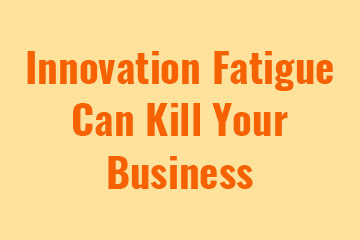
If a business wants to remain relevant, change and innovation are crucial. This is especially true in technology companies. Yet, ‘innovation fatigue’ is common in many businesses and companies often become complacent in their success and falsely cling to the belief that they have conquered the market and that their victory is undeniable and permanent.
When a business management team decides that they have had enough of investing in research, and trying to engender the constant churn of creativity, when a business decides to rest on its laurels, the match usually goes to the completion and, more often than not, that competitor is a young, hungry upstart, rife with excitement and ideas!
And, so it goes!
The market shifts, customer allegiance wanes and businesses like Nokia and Kodak find themselves in an untenable position. The field is littered with businesses that once dominated their market and went on to go bankrupt, to be acquired. In some cases, a company is successful in recognizing the slide, and fighting their way back to success but the road can be long and along the way, the business will lose customers, and be forced to rebuild their brand, and their reputation.
Consider the evolution of 8 track tapes to CD’s, VCRs to DVD players, land lines to car phones to smart phones – there are so many examples of evolution and innovation that one only has to look back over the last decade to see how rapidly things have changed, and how many big successful companies have lost momentum by failing to embrace change!
There is a reason that the Total Quality Management (TQM) concept includes a continuous improvement process. If an executive team fails to recognize the constant shift and change of their world, their market, and their customer buying behavior, that executive team will steer the company off a cliff!
I have spent my career in the technology business and I have watched as the pace of change gains speed. It is exciting and somewhat daunting to see how new ideas and approaches challenge our assumptions and force us to rethink products, services, business models and competitive efforts.
We started with JavaBeans development components, then PDF library, then Charting library, then Reporting to BI and now we have transformed to Augmented Analytics.
Though investment was never easy for us being a small company, we would have been no one today in the analytics market, if we had not done this transformation.
Not recent, but certainly a famous event.
During a Press Conference to announce the Microsoft acquisition of Nokia, the Nokia CEO, Stephen Elop said, “we didn’t do anything wrong, but somehow we lost”. One can interpret his statement as a defense of his management decision to ‘stay the course’ and, whether the word ‘wrong’ is appropriate to use in this instance or not, the truth is that a decision to stay the course, especially in a technology business, is a decision that will negatively impact the company and its competitive position.
As I said at the beginning of this article, change and innovation are crucial to business success. There are many factors involved in ‘innovation fatigue’ and in the decision to ignore the need for change.
Here are just a few:
- Complacency and a belief that the business ‘owns the market’
- Ignorance of the competitive environment
- Limited customer relationship and awareness of customer buying behaviors and expectations
- Unwillingness to accommodate trends and patterns driving future growth and technology
- Limited research budget and/or resources
- Inability to attract young, research oriented talent and foster innovation in the team
- Bureaucratic culture and approval policies that discourage and restrict innovation
Whatever the situation, whatever the business, whatever the market, one thing always hold true: Change is constant and in today’s world, it is more rapid than ever. A wise business strategy will always incorporate and recognize change in its success equation!











